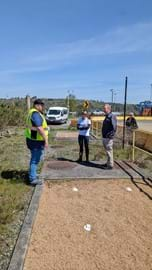
A more robust external verification process for Green Marine
Nuts & boltsGreen Marine consistently applies its core value of continual improvement to the organization itself with its latest efforts focused on verification.
“It’s important to us to make certain that our verification process has the same high quality of standards as similar certification programs internationally,” says David Bolduc, Green Marine’s president. “We also want to make sure that our verifiers are fully trained to properly review a participant’s self-evaluation as our program’s requirements evolve or expand.”
Green Marine contracted the ECO Canada consulting firm last May to review the entire verification process. “The consultants identified a few gaps, most of which we already had on our radar,” says Thomas Grégoire, Green Marine’s program manager responsible for overseeing the verification review.
It’s great to have outside validation that we’re headed in the right direction in addressing a few matters to enhance the consistent quality of the verification services provided to our participants
Rotating site visits
One of Green Marine’s first priorities involved clarifying how participants that choose to report on multiple locations within a single evaluation must go about their verifications. “We wanted to make sure that this reporting properly takes into consideration each of the locations,” Grégoire explains.
When a participant chooses to include multiple locations in one evaluation, the site with the lowest ranking is used as the year’s achieved level for that performance indicator. For example, if Terminal X obtains a Level 3 for waste management, that’s the score recorded even if other company locations fared better. Results are not aggregated in an average.
In the past, a verifier could repeatedly visit the same location and would often choose or be invited to the location at or closest to a company’s head office. A participant reporting on multiple locations must now provide a schedule that relates when all the locations will be visited by a verifier over time.

“We think it’s important that a verifier eventually visits all of the locations during the course of future verifications,” Grégoire shares.
The number of different site visits required during each verification process also increases for participants with more locations. For example, a participant with five to eight locations must now have at least two of those sites visited during the verification process required every two years. The two locations must also be new to the verifier for each subsequent verification process until all locations are visited and the rotation begins again.
We want to ensure that all our criteria are understood, applied and evaluated with consistency at the different locations and reviewed as having a consistent rigour and transparency
Geographic considerations
A need to expand the pool of verifiers was also realized by Green Marine and confirmed by ECO Canada. “For example, 10% of our participating membership is in the North Atlantic region but none of our verifiers are currently located east of Montreal,” Grégoire notes. “The distance can make it more costly to have an onsite verification done because of the additional travel and time involved.”
After conducting a gap assessment to identify regions where verifiers were lacking, Green Marine worked with the global sustainability firm ERM Stratos to develop a plan to recruit and train more verifiers.
The need for this expansion spurred the overall review. “We wanted to make sure that before we seek out additional verifiers, we had the proper criteria to continue to recruit qualified individuals based on Green Marine’s expanding membership and scope of our program,” Bolduc says.
We also wanted to make sure that all our training information and resources were up to date before opening the pool to new verifiers
Grégoire has been working with ERM Stratos to ensure that all the training materials are updated with Green Marine’s latest policies, procedures and terms of reference. “We’re also reviewing the bank of questions and case studies that we present to candidates, to ensure they reflect Green Marine’s larger participating membership and certification requirements,” he adds.
New Code of Conduct
Other major changes are the recent development of a Code of Conduct for verifiers, as well as a dispute resolution process. “We’ve always been able to work out differences of opinion but it’s good to have these formalized in case they’re needed,” Grégoire says.
If a participant and verifier cannot agree on whether the criteria have been met (or is applicable) for a specific level within a performance indicator, a formal dispute can now confidentially be submitted to Green Marine. “There will then be the opportunity for us to obtain third-party technical expertise, if that’s deemed necessary, before a subcommittee of the Green Marine board of directors rules on the issue,” Grégoire says.
“Most of the time, a matter is quickly cleared up by us clarifying the intentions of specific criteria to a participant, or the participants actually showing us why a certain indicator or criteria wouldn’t apply to their operations,” he adds. “Given our broad membership base, we understand that such cases will arise occasionally, and need to be addressed individually.”
No conflicts of interest
Verifiers must be environmental consultants with experience in the maritime industry. “They must have recognized certification as an environmental auditor,” Grégoire adds.
Green Marine also stipulates that if a verifier or anyone from that verifier’s firm has done work for a participant related to the Green Marine program within the previous two years, that verifier cannot review that participant’s environmental performance for that verification period. “We don’t want verifiers reviewing their own work or recommendations,” Grégoire explains.
Unlike an auditor who can request to check anything related to a company, the verifiers focus exclusively on whether the participant has met the Green Marine criteria’s requirements for each of the program’s applicable indicators.
“Most of the criteria are straightforward along the lines of Do you have a greenhouse gas inventory, yes or no? but for some of the indicators, the specifics are detailed in the accompanying annexes to ensure a clear and common understanding of the requirements,” Grégoire explains.
So, for example, the verifiers will check that the proper calculations and emission factors were used in establishing a greenhouse gas inventory
Regular spot checks

To ensure consistency among the work of the verifiers, Green Marine program managers can opt to “shadow” a verifier during a site visit.
Green Marine also does “spot checks” on the internal reports that verifiers are required to provide to confirm the levels that a participant has related through Green Marine’s Smart Guide self-evaluation tool.
“As part of this report, the verifiers relate their mandate, what they considered within and outside the verification’s scope, as well as the justification they accepted as proof of the performance levels reported,” Grégoire explains. “It’s important to note that we’re not doing this to check on the participant’s reporting, but rather to ensure there’s consistency in the quality of the work done and related by each of our verifiers.”
Once each year’s review is done, Green Marine randomly selects a report from each of the three verifiers who have completed the most verifications in that period, as well as three other random selections from the overall pool of verifiers who have completed at least one report.
“Any verifiers who have conducted their very first verification will also have a report reviewed by Green Marine,” Grégoire adds.
All of these reviews on our part assess whether the verifier met the verification requirements and specify if there are essential improvements to be made or recommended general areas for improvement
Back on site!
Site visits by the verifiers resumed this year in keeping with the practices of other international programs that also switched to remote verifications when the COVID-19 pandemic hit. “This was the first year that we returned to onsite verifications which included a verifier meeting in person with each participant and taking a tour of the facilities of landside participants,” Thomas Grégoire, Green Marine’s program manager responsible for the verification process, says. “This applied to those participants who had their 2022 results verified.”
Verifiers did their very best to communicate with online platforms as well as email and telephone exchanges throughout the pandemic travel restrictions, according to David Bolduc, Green Marine’s president.
We truly appreciate their efforts, but we also know that nothing beats going on site to see something for yourself, as well as to discuss any required clarifications in person with a company’s appointed managers.
The external verification period for the 2023 results will run from March 15 to May 3, 2024.
___________________
READ MORE ON THIS TOPIC:
Green Marine’s first-ever verifier calls it a day after 14 years of providing his expertise
